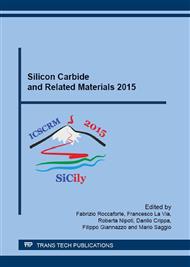[1]
VV. Afanas'ev, F. Ciobanu, S. Dimitrijev, G. Pensl, and A. Stesmans, Band alignment and defect states at SiC/oxide interfaces, J. Phys.: Condens. Matter 16 (2004) S1839.
DOI: 10.1088/0953-8984/16/17/019
Google Scholar
[2]
P. Déak, J. Knaup, T. Hornos, C. Thill, A. Gali, and T. Frauenheim, The mechanism of defect creation and passivation at the SiC/SiO2 interface, J. Phys. D 40 (2007) 6242.
DOI: 10.1088/0022-3727/40/20/s09
Google Scholar
[3]
A. Gavrikov, A. Knizhnik, A. Safonov, A. Scherbinin, A. Bagaturyants, B. Potapkin, A. Chatterjee, and K. Matocha, First-principles-based investigation of kinetic mechanism of SiC(0001) dry oxidation including defect generation and passivation, J. Appl. Phys. 104 (2008).
DOI: 10.1063/1.3006004
Google Scholar
[4]
T. Ono and S. Saito, First-principles study on the effect of SiO2 layers during oxidation of 4H-SiC Appl. Phys. Lett. 106 (2015) 081601.
DOI: 10.1063/1.4913598
Google Scholar
[5]
S. Dhar, S. Haney, L. Cheng, S. -R. Ryu, A. K. Agarwal, L. C. Yu, and K. P. Cheung, Inversion layer carrier concentration and mobility in 4H–SiC metal-oxide-semiconductor field-effect transistors, J. Appl. Phys. 108 (2010) 054509.
DOI: 10.1063/1.3484043
Google Scholar
[6]
G. Liu, B.R. Tuttle, and S. Dhar, Silicon carbide: A unique platform for metal-oxide-semiconductor physics, Appl. Phys. Rev. 2 (2015) 021307.
DOI: 10.1063/1.4922748
Google Scholar
[7]
Y. Matsushita, S. Furuya, and A. Oshiyama, Floating Electron States in Covalent Semiconductors, Phys. Rev. Lett. 108 (2012) 246404.
DOI: 10.1103/physrevlett.108.246404
Google Scholar
[8]
Y. Matsushita and A. Oshiyama, Interstitial Channels that Control Band Gaps and Effective Masses in Tetrahedrally Bonded Semiconductors, Phys. Rev. Lett. 112 (2014) 136403.
DOI: 10.1103/physrevlett.112.136403
Google Scholar
[9]
K. Hirose, T. Ono, Y. Fujimoto, and S. Tsukamoto, First Principles Calculations in Real-Space Formalism, Electronic Configurations and Transport Properties of Nanostructures, Imperial College, London, (2005).
DOI: 10.1142/p370
Google Scholar
[10]
J. R. Chelikowsky, N. Troullier, and Y. Saad, Finite-difference-pseudopotential method: Electronic structure calculations without a basis, Phys. Rev. Lett. 72 (1994) 1240.
DOI: 10.1103/physrevlett.72.1240
Google Scholar
[11]
T. Ono and K. Hirose, Timesaving Double-Grid Method for Real-Space Electronic-Structure Calculations, Phys. Rev. Lett. 82 (1999) 5016.
DOI: 10.1103/physrevlett.82.5016
Google Scholar
[12]
T. Ono and K. Hirose, Real-space electronic-structure calculations with a time-saving double-grid technique, Phys. Rev. B 72 (2005) 085115.
DOI: 10.1103/physrevb.72.085115
Google Scholar
[13]
T. Ono, M. Heide, N. Atodiresei, P. Baumeister, S. Tsukamoto, and S. Blügel, Real-space electronic structure calculations with full-potential all-electron precision for transition metals, Phys. Rev. B 82 (2010) 205115.
DOI: 10.1103/physrevb.82.205115
Google Scholar
[14]
P.E. Blöchl, Projector augmented-wave method, Phys. Rev. B 50 (1994) 17953.
DOI: 10.1103/physrevb.50.17953
Google Scholar
[15]
L. Kleinman and D.M. Bylander, Efficacious Form for Model Pseudopotentials, Phys. Rev. Lett. 48 (1982) 1425.
DOI: 10.1103/physrevlett.48.1425
Google Scholar
[16]
N. Troullier and J.L. Martins, Efficient pseudopotentials for plane-wave calculations, Phys. Rev. B 43 (1991) (1993).
DOI: 10.1103/physrevb.43.1993
Google Scholar
[17]
S. H. Vosko, L. Wilk, and M. Nusair, Accurate spin-dependent electron liquid correlation energies for local spin density calculations: a critical analysis, Can. J. Phys. 58 (1980) 1200.
DOI: 10.1139/p80-159
Google Scholar


